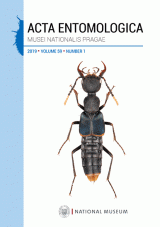Three endemic Aphaenogaster from the Siculo-Maltese archipelago and the Italian Peninsula: part of a hitherto unrecognized species group from the Maghreb? (Hymenoptera: Formicidae: Myrmicinae)
Alicata Antonio, Schifani Enrico
Acta Entomologica Musei Nationalis Pragae 59(1): 1-16, 2019
Published online: 28th January 2019
Published in print: 10th August 2019
Views: 1733
Abstract: More than 100 years ago, the Italian myrmecologist Carlo Emery described two
endemic Sicilian ants: Aphaenogaster sicula Emery, 1908, which he originally
considered a subspecies of A. crocea André, 1881, and A. fiorii Emery,
1915 stat. nov., which he believed was a subspecies of A. gibbosa (Latreille,
1798). Males of the two species and the queen of A. fiorii were never described.
The scarcity of information contained in the original description led to several
misunderstandings by subsequent authors: for example, A. sicula was later
elevated to species-rank on the basis of misidentified material of A. fiorii
stat. nov. We redescribe the two species, adding the descriptions of their
missing castes and designating their lectotypes. We also describe a third
related species of the genus: A. trinacriae sp. nov. from Sicily. The ecology
and distribution of the three are illustrated. Their relationship with the other
congeneric species of the Mediterranean basin is discussed considering the
morphology of all three castes, with attention to the often-overlooked males.
Despite the fact that A. fiorii and A. sicula were lately believed to be close
relatives of A. subterranea (Latreille, 1798), the morphological elements
available suggest that they probably belong to a separate, hitherto unrecognized
clade from the Maghreb (North-Western Africa), together with A. trinacriae
sp. nov.
Key words: Hymenoptera, Formicidae, Stenammini, allopatric speciation, ant males, biogeography, Mediterranean basin, Palaearctic Region
Papers
Three endemic Aphaenogaster from the Siculo-Maltese archipelago and the Italian Peninsula: part of a hitherto unrecognized species group from the Maghreb? (Hymenoptera: Formicidae: Myrmicinae)A new species of the myrmecomorphic planthopper genus Formiscurra (Fulgoroidea: Caliscelidae) from EthiopiaTaumacera revisited, with new synonyms, new combinations and a revised catalogue of the species (Coleoptera: Chrysomelidae: Galerucinae)Neolimnophila alaskana (Alexander, 1924) stat. nov., a species new to the Palaearctic Region (Diptera: Limoniidae)Description of Gondwanoscurus curleri sp. nov. from the West Usambara Mts, Tanzania (Diptera: Psychodidae)A new species of the genus Brachycoleus (Hemiptera: Miridae), with a revised identification key to the species found in IranTaxonomic review for the Asian taxa of plant bug tribe Hallodapini, with emphasis on stridulatory mechanism (Hemiptera: Heteroptera: Miridae)Cretobrachygluta gen. nov., the first and oldest Brachyglutini in mid-Cretaceous amber from Myanmar (Coleoptera: Staphylinidae: Pselaphinae)First Sphaeroceridae (Diptera) endemic to Madeira – three new terricolous species of Spelobia and PullimosinaNew taxa of Neotropical Coreidae of the tribes Acanthocerini and Nematopodini (Hemiptera: Heteroptera)On the genus Philomyceta of China (Coleoptera: Staphylinidae: Staphylininae)Morphology of bromeliad-associated immature stages of Daiphron bipartitus and its adults confirms the non-monophyly of the genus (Coleoptera: Cantharidae)Leaf litter and moss-inhabiting flea beetles of Hong Kong (Coleoptera: Chrysomelidae: Alticini)The genus Harmonia (Coleoptera, Coccinellidae) in the Middle East regionStudies of the genus Anthelephila Hope (Coleoptera: Anthicidae). Part 19. New species from Indonesia and MalaysiaA new species and a new record of the genus Scymbalopsis (Coleoptera: Staphylinidae: Paederinae: Paederini)New taxa and new records of Erythroneurini from China (Hemiptera: Cicadellidae: Typhlocybinae)Discovery of the genus Airaphilus (Coleoptera: Silvanidae) in Japan, with a description of a potentially endangered new speciesThe first hygropetric Platynectes and its larva from eastern China (Coleoptera: Dytiscidae)A review of Thysanarthria with description of seven new species and comments on its relationship to Chaetarthria (Hydrophilidae: Chaetarthriini)Aquatic Coleoptera of North Oman, with description of new species of Hydraenidae and HydrophilidaeA review of the Barsine perpallida-B. yuennanensis species-group, with descriptions of six new species (Lepidoptera: Erebidae: Arctiinae)Two new species and ten new records of Heteroptera from Turkey, including the first record of the potential alien Campylomma miyamotoi in the Western PalaearcticA review of the genus Olophrinus from China (Coleoptera: Staphylinidae: Tachyporinae)Two new species of Rohdendorfi a (Diptera: Syrphidae) from Central AsiaFirst Mexican record of Neoarisemus maesi with the description of the female (Diptera: Psychodidae)Discovery of termitophilous tenebrionid beetles in China (Coleoptera: Tenebrionidae) 